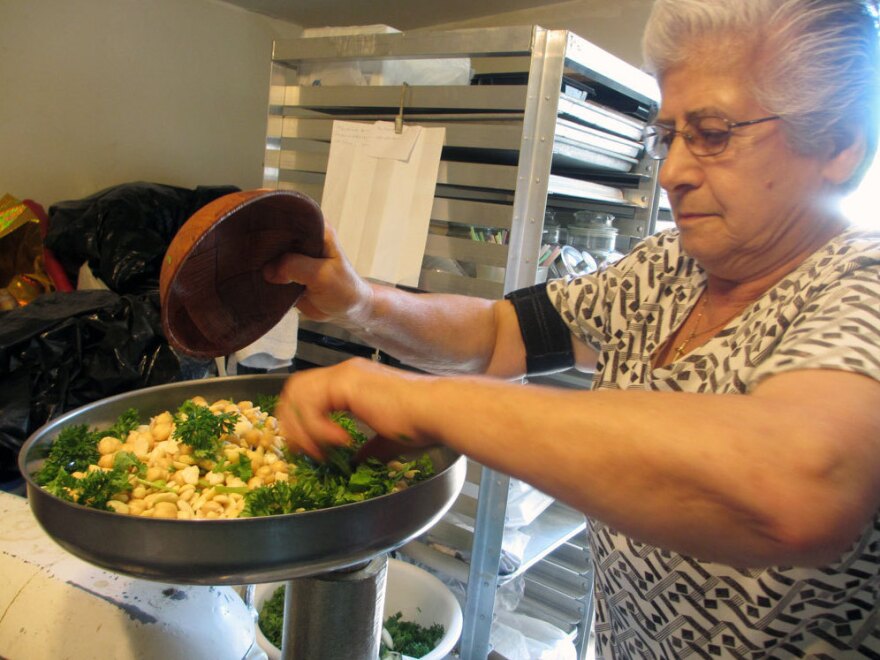Falafel — those crispy, filling fried balls of mashed beans, herbs and spices — is found in cafes and homes all over the Middle East and parts of Africa. It's like a common language shared among sometimes fractious nations.
But until recently, I always thought falafel was made one way — garbanzo beans, onion, garlic, parsley, cilantro and cumin. (That's how my Sudanese mother taught me.) But it turns out there are many recipes out there, each with a flavor distinct to its region.
So I set out to investigate in my backyard — the Bay area, in California. At my first stop, in Fremont, I met falafel-maker Ramzi Totari, who came to the U.S. from Israel to go to college.
"The falafel is part of the tradition in every one of the Middle East countries," says Totari, who owns Falafel, etc. "Every street corner has a falafel stand on it. We don't have hamburger stands, we have falafel stands."
Totari was born in Nazareth, Israel, where his father owned a falafel shop. He's Israeli-Palestinian, and where he comes from, Palestinians and Jews make falafel pretty much the same way.
First off, the oil has to be hot so the falafel balls dive like swimmers to the bottom and rise back up again. The idea is to get the falafel balls crunchy on the outside, but not oily on the inside.
Despite being proud of his falafel chops, Totari admits the dish most likely originated in Egypt.
That led me to Pharaoh's Mediterranean Sandwich Shop, an Egyptian-style restaurant that recently opened in San Francisco. Not surprisingly, falafel, or taameya, as most Egyptians call it, is one of their best sellers.

In the back kitchen of the restaurant, Yasmin Elmorsy explains that the Egyptian style of falafel is made with fava beans, not garbanzo beans.
"We are Egyptians eating fava beans from so long ago," she says, "so surely the pharaohs are the first to make the falafel!"
Middle Eastern cookbook writer and cultural anthropologist Claudia Roden says traces of fava beans have been found in tombs of the pharaohs, and some believe paintings inside the tombs show cooks making falafel. But Roden says no one can be sure.
Another theory posits the dish originated with Egypt's Coptic Christians as a substitute for meat during Lent.
Now, thousands of years later in San Francisco, Elmorsy, her father and four brothers are running a restaurant that offers falafel made the same way.
She mixes the fava beans with cilantro, parsley and onion until it's as smooth as possible. Then she adds spices: salt and pepper, sesame, and most importantly, coriander. After a few minutes of frying, the falafel look more like small hamburgers than balls.
Why Egyptians use fava beans and others garbanzo may have more to do with available food crops than taste. But I also learned that there is a third way — a hybrid.
"Fava beans and garbanzo beans. It's my Lebanese way!" laughs Leila Sfeir. She moved here from Lebanon with her family more than 30 years ago and runs a small catering business in Fremont.

Sfeir 's mixture — chock full of parsley and cilantro, looks more vegetable-y than bean-y. Her falafel balls, a bright green hue, get deep fried in a wok on the stove before being wrapped in pita bread with lettuce and tomatoes.
And? "Tahini sauce," she says. "Soak it good."
So maybe it's not really who makes the best falafel, but, as Roden says, "It's the way you were brought up eating it that means everything to you."
Falafel Recipe
by Hana Baba's mother, Nawal Elbager, of Sudan
(makes about 20 servings)
Ingredients:
3 cups dried garbanzo beans, soaked overnight
1 tablespoon salt
1 tablespoon minced garlic
3 tablespoons chopped Italian parsley
Half a yellow onion, chopped
1 tablespoon baking soda
Oil for frying
(1 teaspoon salt/1 teaspoon ground cumin for final sprinkling of finished falafel)
Process:
Mix all ingredients in a food processor until smooth. This is the falafel mix.
Prepare frying pan with plenty of oil for deep frying.
Scoop up a portion of the falafel mix, roll it in your palm into a ball, then flatten slightly by patting the top. Drop it carefully into the oil once the oil is hot.
The falafel is ready when the color turns light brown. Drain on paper towels.
Prepare a mixture of 1 teaspoon salt and 1 teaspoon ground cumin and sprinkle it on top of the falafel and enjoy!
PALESTINIAN/ISRAELI VERSION: Follow the above recipe, but add 1/2 tablespoon cumin, 1/2 tablespoon hot sauce and 1/2 cup water after mixing beans, cilantro, parsley, onion and garlic. Use a meat grinder, not a food processor, to keep ingredients from getting too mashed, says Ramzi Tori.
EGYPTIAN VERSION: Follow the above recipe, but substitute split fava beans for garbanzos, swap garlic for 1 tablespoon sesame paste (tahini), swap 3 tablespoons parsley for 1 cup of parsley and cilantro mixed, decorate finished falafel with sesame seeds and ground coriander seeds, says Yasmin Elmorsy.
LEBANESE VERSION: Use 2 cups of favas and 2 cups of garbanzo beans, soaked overnight for this hybrid falafel. The next day, prepare the mix, combining the beans, 2 bunches of parsley, 2 bunches of cilantro, 4 garlic cloves and 1 bunch of green onions in a food processor. Then mix in 1 teaspoon salt, 2 tablespoons sesame seeds and 1 teaspoon cumin. Add 1/2 tablespoon baking soda and 2 tablespoons water to the mix just before frying, says Leila Sfeir.
Copyright 2021 KALW. To see more, visit KALW. 9(MDAxNzg0MDExMDEyMTYyMjc1MDE3NGVmMw004))







